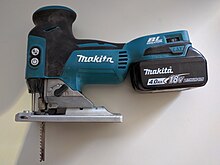Jigsaw
A jigsaw is a hand saw or a hand-held power tool with a narrow, short, one-sided saw blade for cutting cut-outs, curved shapes and expanding small openings.
It is used for work in various materials such as wood and panel materials , plastics , aluminum , thin sheet metal and plasterboard .
Electric jigsaw
With the electric jigsaw, the saw blade clamped on one side cuts with a lifting movement. In modern jigsaws, the back of the saw blade is supported by a roller in order to guide the saw blade. The support table can often be swiveled on both sides by up to 45 ° in order to produce bevel cuts.
In the case of saws with a pendulum stroke, the guide roller pushes the saw blade forwards with each upward stroke in addition to the vertical saw movement. The strength of the pendulum movement is often adjustable in several stages in order to adapt it to the material to be processed and the application. With the pendulum lift, the sawdust is ejected better and the sawing performance is higher. However, the cut becomes less clean and the cut edges can fray.
Saw blades are available in different lengths, thicknesses and widths and for different materials. Knives, rasps and files can also be used in the tool holder. The recordings in the machines differ depending on the manufacturer and are not always compatible. The T-shaft and the universal shaft are widely used .
In many machines, part of the motor's cooling air is blown forward onto the cutting surface in order to remove sawdust so that the “crack” remains visible. Some models illuminate the cut surface or generate a laser beam as a guide. Side guide rails are available as accessories for cutting parallel along straight edges, circular rulers for circular cut-outs and connections for chip extraction with a vacuum cleaner.
With electric jigsaws, plunge cuts without pre-drilling are possible by slowly and carefully tilting the saw, tilted forward, backwards with the engine running. The saw blade gradually dips into the material.
Since the saw blade cuts in the stroke direction, the side facing the machine will fray when cutting into wood. The machine is therefore placed on the "bad" side if possible (the visible side is at the bottom).
Electric jigsaws are helpful in mobile use for on-site adjustments.
Compared to reciprocating saws that work on the same principle , electric jigsaws produce clean cuts and are easier to guide, so they are used for finer work.
history
Albert Kaufmann, at that time an employee of Scintilla AG , invented the electric jigsaw in 1946, the basic idea of which he adopted from his wife's sewing machine . The following year, his company began series production of the machines marketed as the "Lesto jigsaw".
Manual jigsaw
Manual jigsaws are staple saws with handles made of wood or metal. They work in abutment, the narrow, pointed saw blade has a medium tooth pitch. For cutting free the blade of the back is thinner than the teeth.
To make cutouts in closed areas, manual jigsaws require a hole through which the saw blade can be inserted.
Web links
Individual evidence
- ↑ a b Wolfgang Nutsch and others; Expertise for joiners , 12th edition, Verlag Europa-Lehrmittel OHG, Wuppertal 1980, page 235, ISBN 3-8085-4011-7
- ↑ a b c d Wolfgang Nutsch and others; Expertise for carpenters , 12th edition, Verlag Europa-Lehrmittel OHG, Wuppertal 1980, page 298, ISBN 3-8085-4011-7
- ↑ a b c Jigsaw in the DIY lexicon on DIY4you.de by Michael Blömeke
- ↑ Various jigsaw blade recordings in the overview on DIY4you.de by Michael Blömeke
- ^ History of Scintilla AG , on scintilla.de
- ↑ Jigsaw - how does it work? on the DDS online website , December 8, 2012, accessed on June 26, 2016
- ^ Bildungsverlag EINS (editor): Table book wood occupations , Troisdorf 2002, page 150, ISBN 3-441-92350-2






